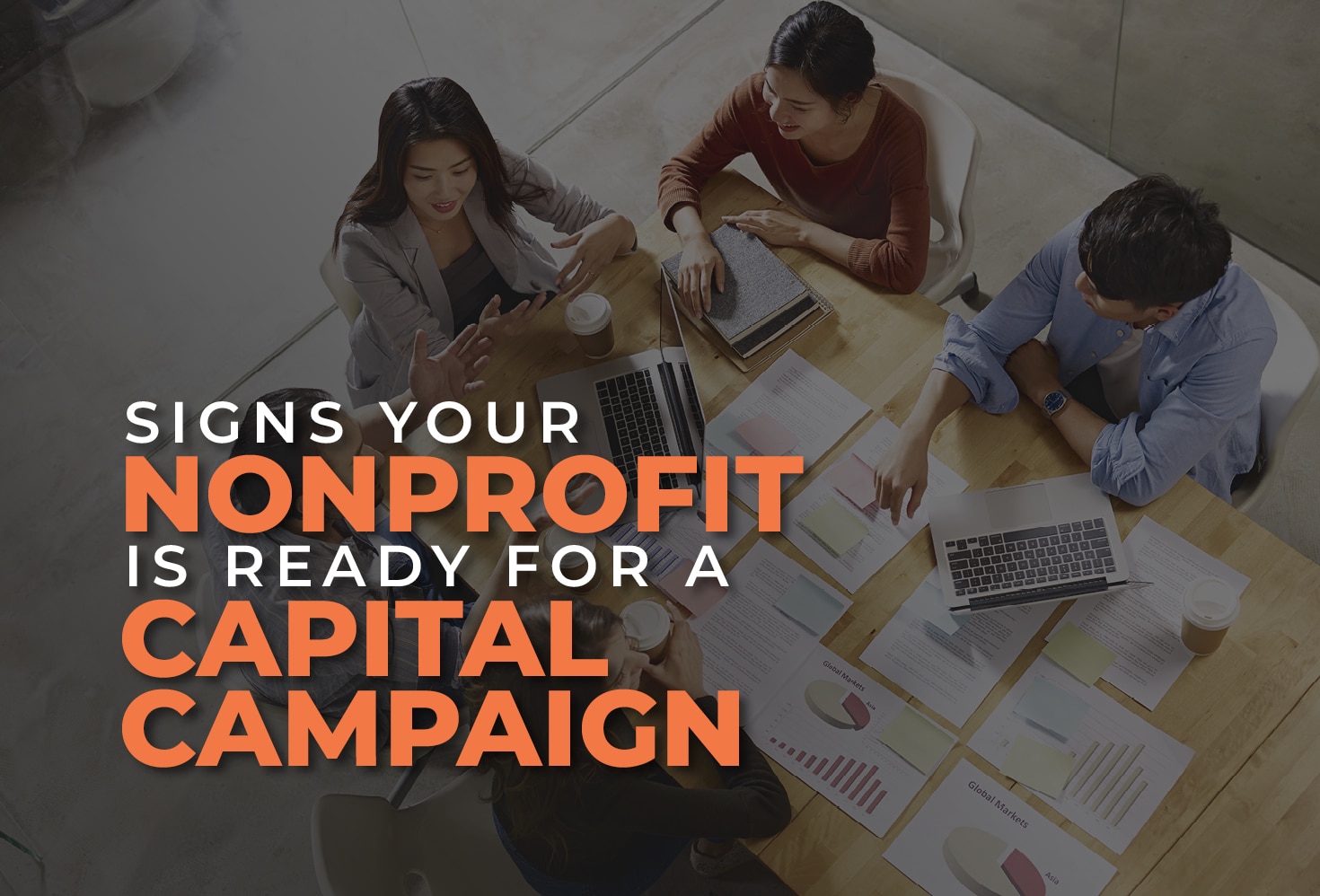
To help your nonprofit grow and enable you to devote more resources to your mission, you have to set ambitious fundraising goals. Sometimes, this means launching a years-long fundraising effort known as a capital campaign to raise money for a construction project, expansion, or other major investment in your organization’s growth.
Capital campaigns are exciting projects, but they require extensive planning and research to be successful. This makes it essential to ensure your nonprofit is ready for the commitment before you dive in. We’ll explore five signs you can look for to see if your organization is ready to start planning:
- You have a clear expansion project in mind.
- You have a solid base of involved donors and supporters.
- Your board is excited about a potential campaign.
- You can identify major donors and lead gifts.
- You have resources to invest in the campaign’s success.
With the right amount of preparation and support, nonprofits of any size can reach their capital campaign goals and massively increase the scale of what they can accomplish. Let’s explore these indicators that it may be time for you to move forward with your own.
1. You have a clear expansion project in mind.
If your nonprofit has more constituents than you’re able to effectively serve, that’s a sign you could benefit from an increase in structural capacity. When your constituents’ needs increase, your programs, facilities, and initiatives need to grow with them to meet those new demands.
For a capital campaign, however, you need more direction than a broad notion that your organization needs to expand. Early on, you should determine exactly why you need to expand, what you need to do to expand, and how the expansion will help you meet additional needs.
For example, a food bank launching a capital campaign to raise funds for a new facility might articulate its needs in this way:
- What: A new 5,000 sq ft building with five times the pantry space, commercial cooling equipment, and room for staff offices.
- Why: Our current 1,000 sq ft facility does not have adequate room to accommodate the number of annual food drives that we facilitate.
- How: The additional capacity will allow us to double our monthly meal distributions for existing pantry clients, serve up to 500 new families, and reduce wait times for all.
If your organization can clearly articulate a project like the example above, it’s a sign that you may be ready for a significant fundraising effort like a capital campaign.
2. You have a solid base of involved donors and supporters.
Capital campaigns require a significant amount of involvement from a wide breadth of players, including board members, donors, volunteers, and members of the community. This makes it essential to have a committed base of supporters both inside and outside of your organization.
To verify that you have a strong enough support base to launch a capital campaign, analyze your donor data and ensure that:
- Your donor base is growing year over year.
- Supporters are engaged and involved in your organization’s campaigns, initiatives, and programs.
- You can easily fill volunteer shifts and meet fundraising event attendance goals.
- The broader community has knowledge of and trust in your organization.
If you can’t confidently say that your nonprofit has a solid, engaged base of supporters, take some time to invest in the health of your outreach and engagement efforts before you dive into a capital campaign.
3. Your board is excited about a potential campaign.
Considering your nonprofit’s board is your organization’s core decision-making body, you’ll need their full participation and endorsement to have a successful capital campaign.
Your board members will have several important responsibilities throughout the course of your campaign, including:
- Signing off on plans and goals. You’ll need collaboration and input from your nonprofit’s board about key financial benchmarks and overarching campaign goals. This makes having a clear, shared vision for your capital campaign essential for success.
- Make introductions to prospects. Your board members have valuable connections in the community. They should be willing to use their personal or professional networks to locate potential major donors and introduce them to your fundraising team.
- Cultivate relationships with potential major donors. Because board members may have previous relationships with some of your major donor prospects, their involvement in the stewardship process can greatly increase your chances of success.
- Contribute to the campaign. Whether they give a monetary gift, volunteer their time, or provide some other form of help, your board members should be willing and excited to contribute personally to your capital campaign.
If your board members aren’t yet willing to take on these responsibilities, take steps to increase board involvement by pursuing a future large-scale campaign. For instance, you might evaluate your board’s performance regularly to hold members accountable or implement a mandatory fundraising policy. Once your board’s engagement is where it should be, a capital campaign is a much more feasible idea!
4. You can identify major donors and lead gifts.
Before launching a capital campaign, it’s essential to use your donor data to identify a handful of prospective major donations that will anchor your campaign. Many nonprofits seek out a “lead gift,” or a single donation of about 15-30% of the campaign’s goal, to confirm the campaign’s viability. Or, in place of the single lead gift, some nonprofits may seek several lead gifts that represent 10-15% of the total goal.

To ensure you can find enough major donors to sustain your campaign, you’ll need to conduct thorough prospect research to identify the best prospects. Donorly’s guide to prospect research explains that this process involves looking for three types of indicators:
- Capacity: Also known as wealth markers, these indicators give you insight into a prospect’s financial ability to give a major gift. Look for markers like high-income careers, real estate ownership, and stock holdings to verify that a prospect has enough financial capacity to give a major or lead gift.
- Affinity: Markers like past donations and involvement with your nonprofit, personal connections to other major donors, and political donations indicate that a prospect has sufficient interest in your cause to be willing to make a major contribution.
- Propensity: Propensity (or habit) markers prove that prospects have a personal habit of giving to nonprofits or other charitable causes. Check if your prospects have donated to other nonprofits, served on a nonprofit board, or regularly attended fundraising events to see if they have a personal commitment to giving.
Most of your major donors will come from your existing donor base, so conduct research on your existing donors first. To make the process easier, Double the Donation suggests creating a donor pyramid that will help you visualize donors’ current giving levels and potential to increase their contributions.
Remember, major donors generally account for 60-80% of the revenue generated from capital campaigns, so it’s crucial that you know who your major donors are early on.
5. You have resources to invest in the campaign’s success.
A capital campaign, regardless of its specific financial goal, is always a significant undertaking that requires years of time and effort. Such a large-scale project will require an injection of resources to effectively run the campaign.
You’ll likely need to bulk up your internal team and allocate resources for:
- Outside consultants. Fundraising consultants with capital campaign experience can help your team with everything from in-depth feasibility studies to campaign strategy to major donor cultivation. They can also determine how much you’ll need to invest in other resources and if that investment is reasonable to expect of your organization.
- Kickoff events. When the time comes to announce your campaign to the public, you should have enough resources to host a kickoff event to celebrate the launch. Budget for the event ahead of time and determine whether you can feasibly host it in person or virtually.
- Marketing materials. Along with traditional email campaigns, direct mail appeals, and social media promotion, you’ll need to create specialized marketing materials for the campaign like a public-facing case for support and a campaign brochure.
- A recognition strategy. Whether you’re planning on including a donor wall in your new building or writing handwritten thank you notes to every donor, you need to have a meaningful way to thank and recognize your donors. Make sure you plan to dedicate either your budget or your team time to creating an effective donor recognition strategy.
Understanding what resources you have available and what you’ll still need to properly execute the campaign will save your team a significant amount of time down the road. Resources like campaign calendars and fundraising strategy templates can also be useful for helping your team conceptualize the additional capacity necessary to accomplish your campaign’s goal.
If you’ve seen these signs in your organization, you’re on the right track to launching your most impactful fundraising campaign yet. If you’re still not sure that you’re ready, don’t worry. There are plenty of expert consultants out there who can help you identify and accomplish everything you need to do to put yourself in a better position to succeed.
About the Author:
Founder and President Sandra Davis leads Donorly with 30 years of fundraising experience and leadership. Sandra has consulted on numerous capital campaigns, led strategic planning and feasibility study efforts, and managed board development and recruitment efforts, planned giving, special events, and annual giving programs. Under her leadership, Donorly has grown to support the fundraising efforts of over 75 clients to date.





